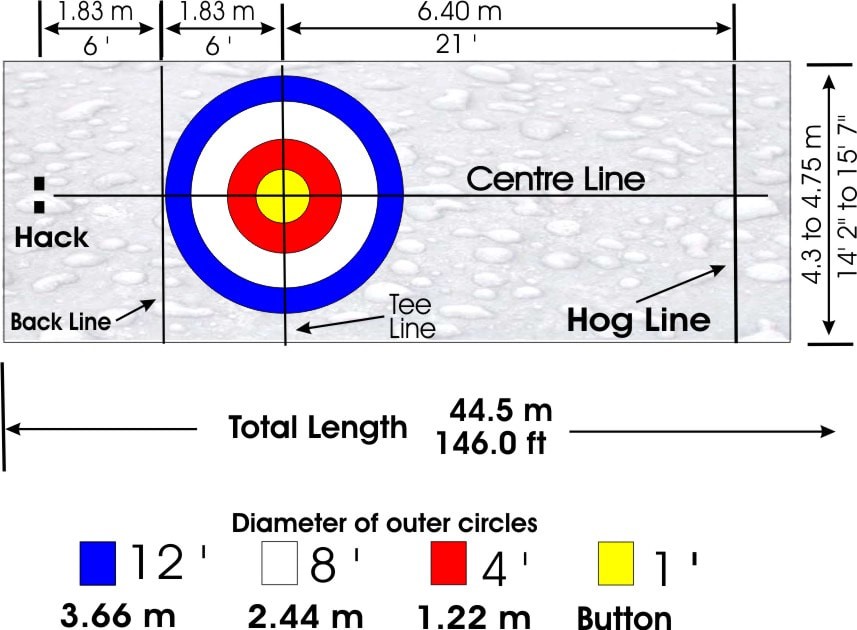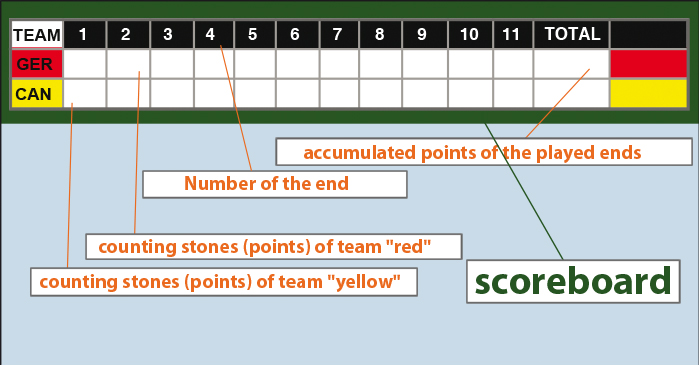Curling Basics
Click here is a quick video to the Sport of Curling
Curling Basics
Curling is a game involving two four-player or two-player teams, granite stones, brooms, and a sheet of ice. All players start a stone moving from a rubber block called “the hack”, teams alternate sliding stones towards a circular target area, called a "house", while their teammates sweep the ice and the skip shouts instructions. The score for each round, or "end", is determined after all 16 stones are thrown, based on whichever team's rock(s) is closest to the middle of the house “button”. Games are eight ends long and take about two hours to play. Competition play is usually 10 end games.
Positions on a Curling Team
There are four members of a curling team and each delivers two stones, in this order: first, the “lead”, second, the “second”, third, the “third” a.k.a. “vice skip”, and fourth, the “skip”. The skip is responsible for the strategy and calls the shots for all the players. She/he stands in the “house” (the rings) at the end opposite to the delivering end (where curlers throw their shots from) and directs the play and yells instructions to the sweepers. The two teams competing against each other take turns delivering stones until all 16 stones have been thrown.
Sweeping
After a stone is thrown, players are allowed to sweep the ice in front of the stone. Sweeping clears the ice of any debris that might slow the stone down or send it off course. Sweeping also melts a thin layer of ice that reduces friction and thus increases the distance the rock travels.
Sweeping is allowed by any player on the throwing team between the two tee lines. Players are not allowed to sweep opponents’ stones in that area.
Behind the tee line at the playing end (where the stones stop moving), only one player from each team may sweep at any one time. This may be any player of the delivering team, but only the skip or vice-skip (third) of the non-delivering team.
Only stones in motion - termed “running stones” - may be swept. Players may not touch any stones while sweeping. Also, they may only sweep in front of the stone, in a direction perpendicular to the direction of motion.
Players are allowed to sweep stones that are set in motion by other stones.
The Curling Sheet
The 4 circles make up the house or target. The other circle is called the 12 foot (3.7 metre) circle, next to it is the 8-foot (2.4 metre) circle and the next circle is called the 4-foot (1.2 metre). Finally, the innermost circle is called the button (or middle point of the house), and is usually one foot in diameter.

Hog line - Delivered stones must be completely over this line to remain in play unless they have come in contact with a stone which is in play. In addition, curlers must release the stone completely before they reach this line at the delivering end of the sheet.
Back line - The line across the sheet at the back of the house. Stones which come to rest completely over this line are out of play.
Tee line - This is the line which goes across the sheet in the middle of the house.
Side lines - Once a stone touches a side line it is out of play.
Free guard zone - The free guard zone (FGZ) rule was invented to encourage more aggressive play by ensuring that, if a "team" desires, a "lead’s" two "stones" could be in play (and not removed by the opposing team) at the beginning of each "end". The FGZ can be used effectively by a "team" without last stone to place "guards" on or near the "centre line", in front of the rings, that can be used to promote or draw behind.
This is the official rule taken from "The Rules of Curling" by the World Curling Federation (WCF):
(a) stone that comes to rest between the tee line and the hog line at the playing end, excluding the house, is deemed to be within an area designated as the FGZ. Also, stones that are in play, on or before the hog line, after striking stones in the FGZ, are deemed to be in the FGZ.
(b) If, prior to the delivery of the sixth stone of an end, a delivered stone causes, either directly or indirectly, an opposition stone to be moved from the FGZ to an out-of-play position, then the delivered stone is removed from play, and any displaced stones are replaced, by the non-offending team, to their positions prior to the violation taking place.
See animation of the Free Guard Zone here
https://www.curlingbasics.com/en/free-guard-zone.html
Types of shots
The strategy of curling mainly involves shot selection. There are several different types of shots:
Draw: A shot designed to stop inside or in front of the house (the concentric circles at the end of the rink). This is the basic scoring shot.
Freeze: A form of a draw that stops in front of another rock.
Guard: A shot that stops in front of the house and is intended to prevent the opponent from hitting a stone in the house.
Hit-and-roll: Generally, a shot designed to take out an opponent’s rock and then roll the shot rock to a designated spot. It is also possible to play a hit-and-roll off the team’s own rock.
Peel: A shot designed to remove another stone, as well as the shot rock.
Raise: A type of draw designed to bump a rock to another position.
Takeout: A shot that removes an opponent’s stone from play. A takeout that is designed to remove a guard is called a peel.
In-turn vs Out-turn
In addition to picking the type of shot, the skip also directs his teammate throwing the stone whether to play an in-turn or an out-turn. A player executes an in-turn by turning the inside of his palm towards his body when releasing the stone. A player executes an out-turn by turning the outside of his palm away from his body.
Stones curve, or curl, as they proceed down the ice - which is where the sport derives its name. Players impart spin on the stone using the handle; the curl allows for better control and also provides a way to shoot around other stones. For a right-handed player an out-turn curls right to left and an in-turn curls left to right. How the stones are positioned on the ice dictates which type of shot the skip calls.
The Hammer
The last shot of an end is called the hammer. The team that shoots last has the advantage. A team will sometimes be willing to give up a point to the other team in order to secure the hammer for the next end. (The team that has earned one or more points shoots first in the next end, while the team that earned zero points receives the hammer.)
Also the team with the hammer will sometimes “blank” the end. This means that instead of taking a single point in the end, they will clear the house so no one scores, thus keeping the hammer for the next end. It is considered a victory for the team without the hammer if they make the other team take only one point. In most cases, the team with the hammer would rather keep the hammer than score one point. A team will almost never blank an end if it has the opportunity to score two or more points.
Scoring
The winner is the "team" having the highest number of accumulated points at the completion of 8 "ends".
If at the end of a competition and the "score" is tied, "extra ends" are played until a winner is decided.
Points are scored at the conclusion of each of these "ends" as follows: when each "team" has thrown its eight "stones", the "team" with the "stone" closest to the "tee" wins that "end"; the winning "team" is then awarded one point for each of its own "stones" lying closer to the "tee" than the opponent's closest "stone".
Only "stones" that are in the "house" are considered in the scoring. A "stone" is in the "house" if it lies within the "twelve foot" (3.7 m) zone or any portion of its edge lies over the edge of the ring. Since the bottom of the stone is rounded, a "stone" just barely in the "house" will not have any actual contact with the ring, which will pass under the rounded edge of the "stone", but it still counts; this type of "stone" is known as a "biter".
If at the end of an "end" no "stone" is in the "house" no team scores in this "end"; this situation is called "blank end".
It may not be obvious to the eye which of two "stones" is closer to the "tee" or if a "stone" is actually biting or not; there are specialized devices to make these determinations, but these cannot be brought out until after an "end" is completed. Therefore, a "team" may make strategic decisions during an "end" based on assumptions of stone position that turn out to be incorrect.
The score is marked on a "scoreboard".

Refereneces
For more information about curling basics please see
https://www.curlingbasics.com/en/what-is-curling-.html
http://www.tsacurlingclub.com/curling101.html
